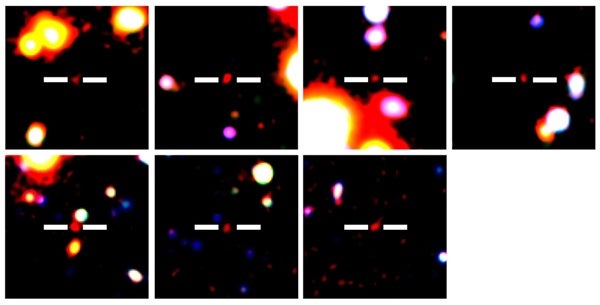LAE galaxies are illuminated by strong hydrogen excitation — called Lyman-alpha emission. The team’s discovery of these LAEs at a distance of 13.1 billion light-years suggests that LAE galaxies appeared rather suddenly in the early universe.
The universe was born in the Big Bang some 13.8 billion years ago. In its earliest epochs, it was filled with a hot “soup” of charged protons and electrons. As the newborn universe expanded, its temperature decreased uniformly. When the universe was 400,000 years old, conditions were cool enough to allow the protons and electrons to bond and form neutral hydrogen atoms. That event is called “recombination” and resulted in a universe filled with a “fog” of these neutral atoms.
Eventually the first stars and galaxies began to form, and their ultraviolet light ionized (energized) the hydrogen atoms and “divided” the neutral hydrogen into protons and electrons again. As this occurred, the “fog” of neutrals cleared. Astronomers call this event “cosmic reionization” and think that it ended about 12.8 billion years ago — about a billion years after the Big Bang. The timing of this event — when it started and how long it lasted — is one of the big questions in astronomy.
To investigate this cosmic reionization, the Subaru team searched for early LAE galaxies at a distance of 13.1 billion light-years. Although the Hubble Space Telescope has found more distant LAE galaxies, the discovery of seven such galaxies at 13.1 billion light-years represents a distance milestone for Subaru.
Konno pointed out the obstacles that Subaru had to overcome to make the observations. “It is quite difficult to find the most distant galaxies due to the faintness of the galaxies,” he said. “So, we developed a special filter to be able to find a lot of faint LAEs. We loaded the filter onto Suprime-Cam and conducted the most distant LAE survey with the integration time of 106 hours.”
That extremely long integration time was one of the longest ever performed at Subaru Telescope. It allowed for unprecedented sensitivity and enabled the team to search for as many of the most distant LAEs as possible. According to Konno, the team expected to find several tens of LAEs. Instead they only found seven.
“At first, we were very disappointed at this small number,” Konno said. “But we realized that this indicates LAEs appeared suddenly about 13 billion years ago. This is an exciting discovery. We can see that the luminosities suddenly brightened during the 700-800 million years after the Big Bang. What would cause this?”
According to the team’s analysis, one reason that LAEs appeared very quickly is cosmic reionization. LAEs in the epoch of cosmic reionization became darker than the actual luminosity due to the presence of the neutral hydrogen fog. In the team’s analysis of their observations, they suggest the possibility that the neutral fog filling the universe was cleared about 13.0 billion years ago and LAEs suddenly appeared in sight for the first time.
“However, there are other possibilities to explain why LAEs appeared suddenly,” said Ouchi who is the principal investigator of this program. “One is that clumps of neutral hydrogen around LAEs disappeared. Another is that LAEs became intrinsically bright. The reason of the intrinsic brightening is that the Lyman-alpha emission is not efficiently produced by the ionized clouds in a LAE due to the significant escape of ionizing photons from the galaxy. In either case, our discovery is an important key to understanding cosmic reionization and the properties of the LAEs in early universe.”
“To investigate which possibility is correct, we will observe with Hyper Suprime-Cam (HSC) on Subaru Telescope, which has a field of view seven times wider than Suprime-Cam, and TMT currently being built on the summit of Mauna Kea in Hawaii in the future,” said Masanori lye, who is a representative of the Thirty Meter Telescope project of Japan. “By these observations, we will clarify the mystery of how galaxies were born and cosmic reionization occurred.”










